One player who was considered a surprise package last season was forward Folarin Balogun.
A product of the Arsenal academy, Balogun enjoyed a successful loan spell at Ligue 1 side Reims, scoring 21 goals in 37 appearances.
Prior to this goal rush, Balogun’s only other consistent taste of senior football came in a loan spell at EFL Championship side, Middlesbrough where he netted just three goals in 18 games.
His form at Reims caught the attention of numerous clubs, and Monaco eventually secured his signature for a reported initial fee of £25.7 million.
However, since moving south to the Principality, Balogun has not enjoyed the same rich vein of form.
The former Gunner has so far netted only four league goals in 15 appearances.
It begs the question of whether the forward is a one-season wonder or whether a change of tact may be needed to get him back firing.
In this tactical analysis and scout report, we will assess Balogun’s performances in front of goal this campaign compared to last.
We will also provide a comparative analysis of the tactics and personnel at Reims and Monaco to determine if there is scope for changes at Stade Louis II in order to get the best out of the forward.
Less opportunities this campaign
During his loan spell at Reims, Balogun was scoring goals for fun last season.
Only three other players scored more in France’s top flight than the USA international.
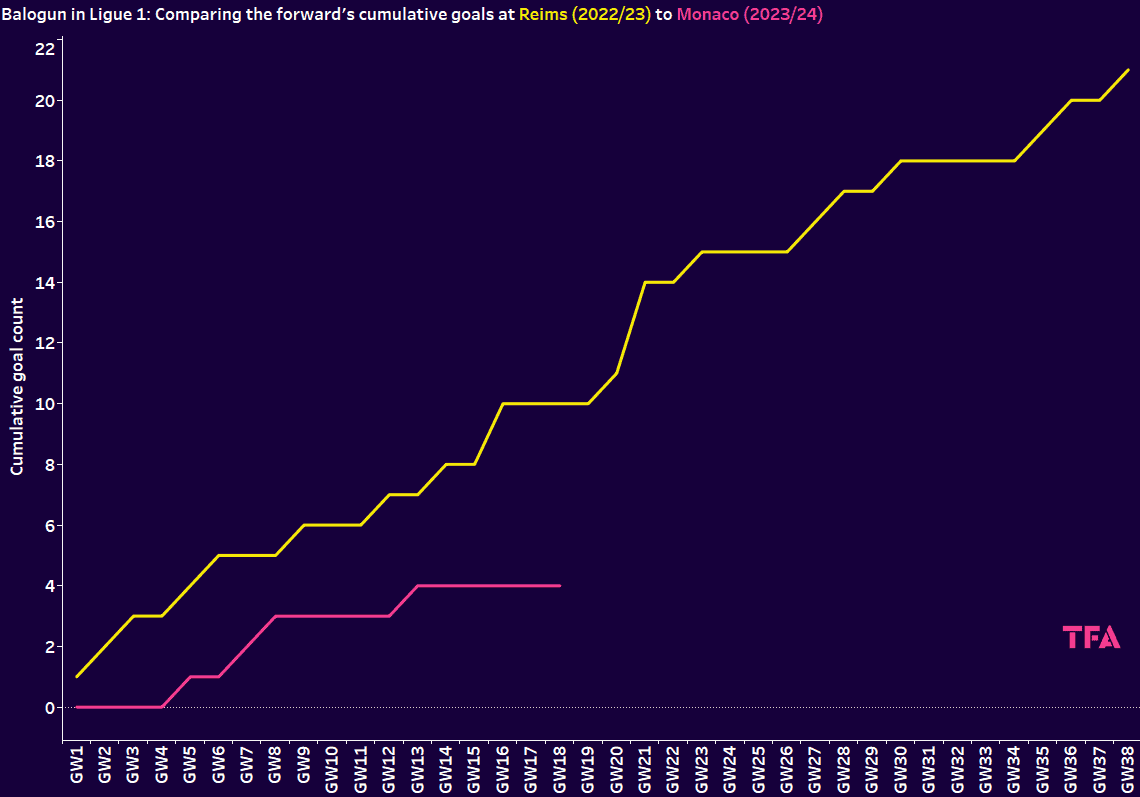
The line graph shows that it has taken Balogun 13 game weeks of the season to reach his current goal tally.
He did, however, not feature in the first three league games for his new side, but nevertheless, under Will Still last season, Balogun took only five league games to achieve the same goal tally.
Moreover, Balogun continued his goal-scoring touch last season, whereas at Monaco he has failed to find the back of the net in his last five league games and last seven in all competitions.
It will be a concern for the Monaco faithful that he hasn’t been able to replicate his form from Reims, as he is currently scoring 0.38 goals per 90, which is much lower than last season’s 0.63 goals per 90.
Although these statistics don’t look favourable for the 22-year-old, his efficiency in front of goal has been similar to last campaign.
Balogun has converted 12% of his Ligue 1 shots at Monaco, only 5% less from his time in North France; 42.4% of his league shots have been on target this season.
This is slightly up from 41.3% whilst at Reims.
These statistics suggest that, given the opportunity, Balogun has been just as adept at finishing at Monaco, but it is finding the same level of opportunities on a consistent basis, which has been harder to come by.
His non-penalty expected goals per 90 last season was 0.63 per 90 compared to just 0.28 per 90 this campaign.
This highlights how Balogun has not been able to find himself in as many promising goal-scoring opportunities since his transfer despite playing in the same division.
The initial evidence points to a change in tactics, potentially being culpable for his declining goal rate.
Less suited to a possession-based philosophy
Under Still last season, Reims began with a 3-4-1-2 formation before switching to a 4-2-3-1.
Regardless of whether Balogun had a striking partner, the Reims tactics were tailored to the strengths of the 22-year-old.
Reims was not a side that would consistently dominate possession in matches but instead would thrive on the counterattack, looking to drive forward upon regaining play.
Still’s sides off-the-ball movements were aggressive, looking to put pressure on the opposition with counterpressing; their defensive actions would predominantly occur in the middle third of the pitch.
However, Balogun was also an important figure in ensuring Reims regained possession in more advanced positions.
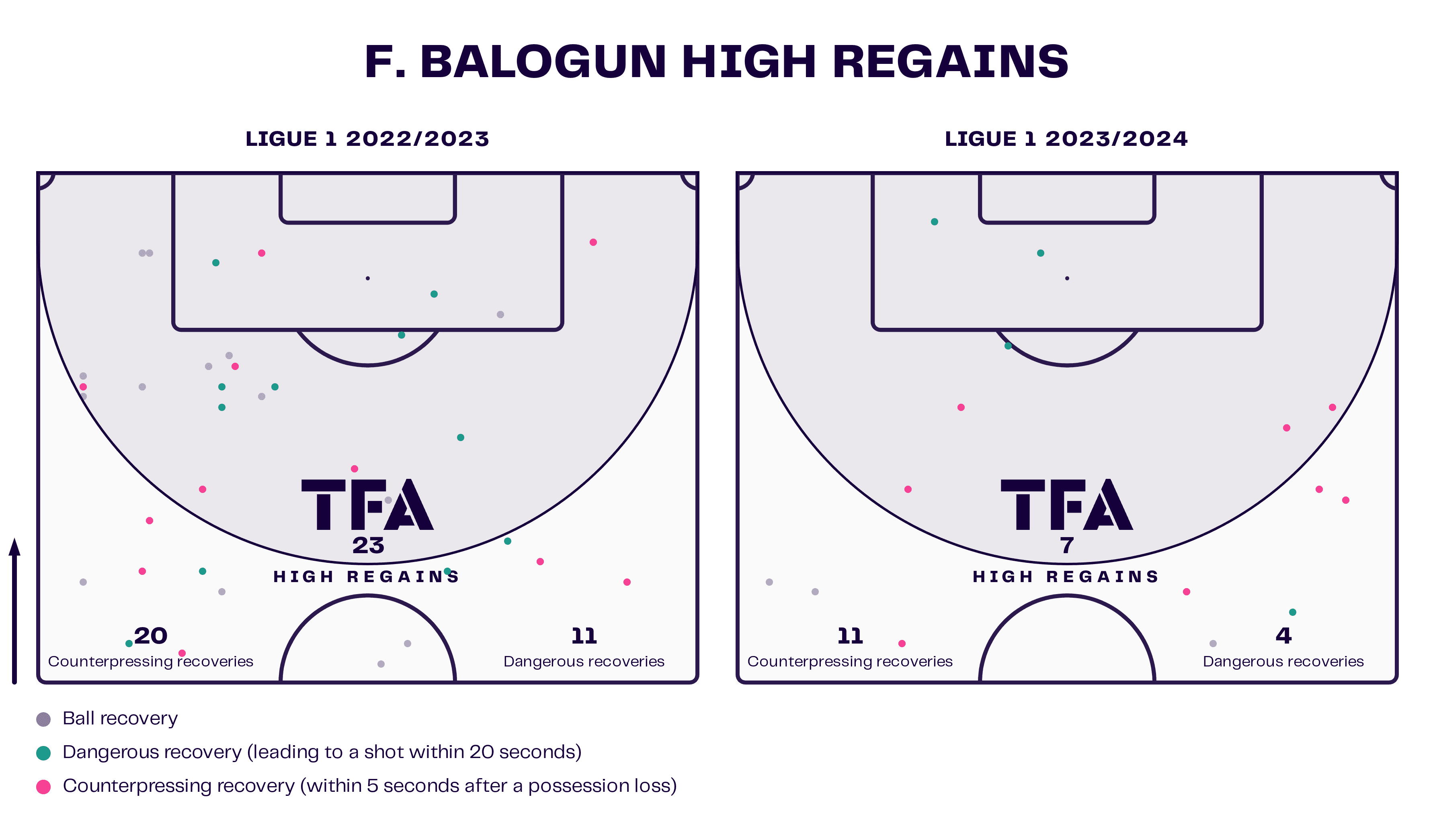
Balogun’s hard work ethic off the ball in the press proved useful at Reims, and when he did regain the ball, it was in dangerous areas.
In contrast, despite Monaco ranking top for pressing credentials, with an 8.4 PPDA, Balogun’s high regains this season have been in less advanced areas, making it harder to carve out more genuine goal-scoring opportunities.
Reim’s general direct approach facilitated quick passing sequences in the attacking phases, and this philosophy suited Balogun, who would use his pace to his advantage, often playing off the shoulder of the central defender.
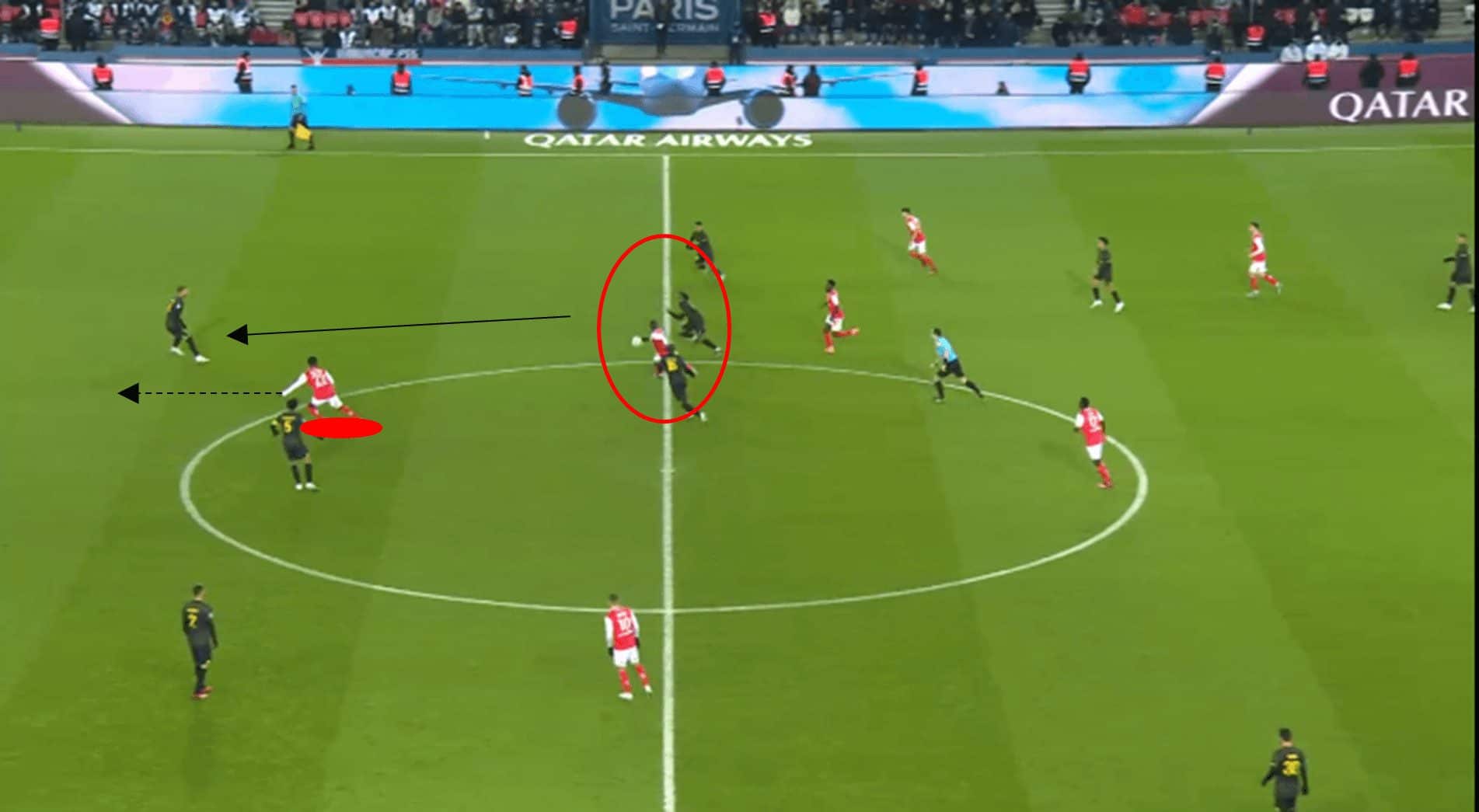
In the above image, Reims wins possession from a loose ball and immediately passes through for Balogun to latch onto.
The young forward anticipated the pass and was already on the front foot to outpace the deepest-lying defender and eventually went on to round the goalkeeper to score.
It was through the central areas that Balogun was particularly lethal whilst at Reims.
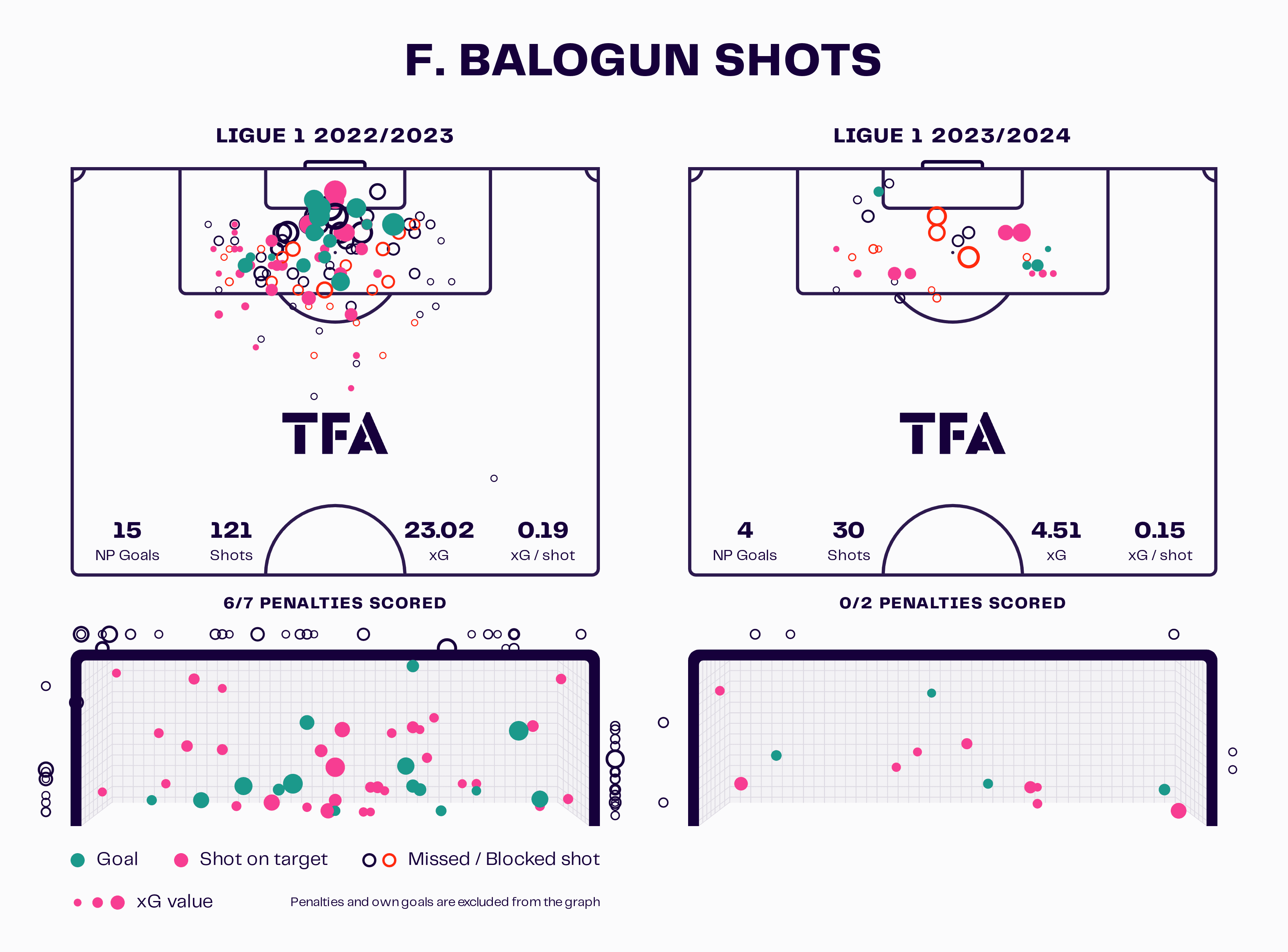
The graphic shows that Balogun rarely attempts shots from outside the area, and the majority of his goals last season came from central areas, in the box, which warranted higher goal expectancies.
In contrast, this season, it is shown that Balogun has had shots from much tighter angles, particularly to the left of the goal, where the chances of scoring are less.
Balogun appeared much more confident in front of goal last season, having the ability to find more space in the box to get on the end of crosses.
His confidence from last season is further exemplified in the above graphic, considering he scored six out of seven penalties, whereas he has failed to dispatch his two penalty opportunities this season.
In addition, although Balogun’s touch can let him down at times, he is comfortable carrying the ball.
He used this strength to his advantage whilst at Reims.
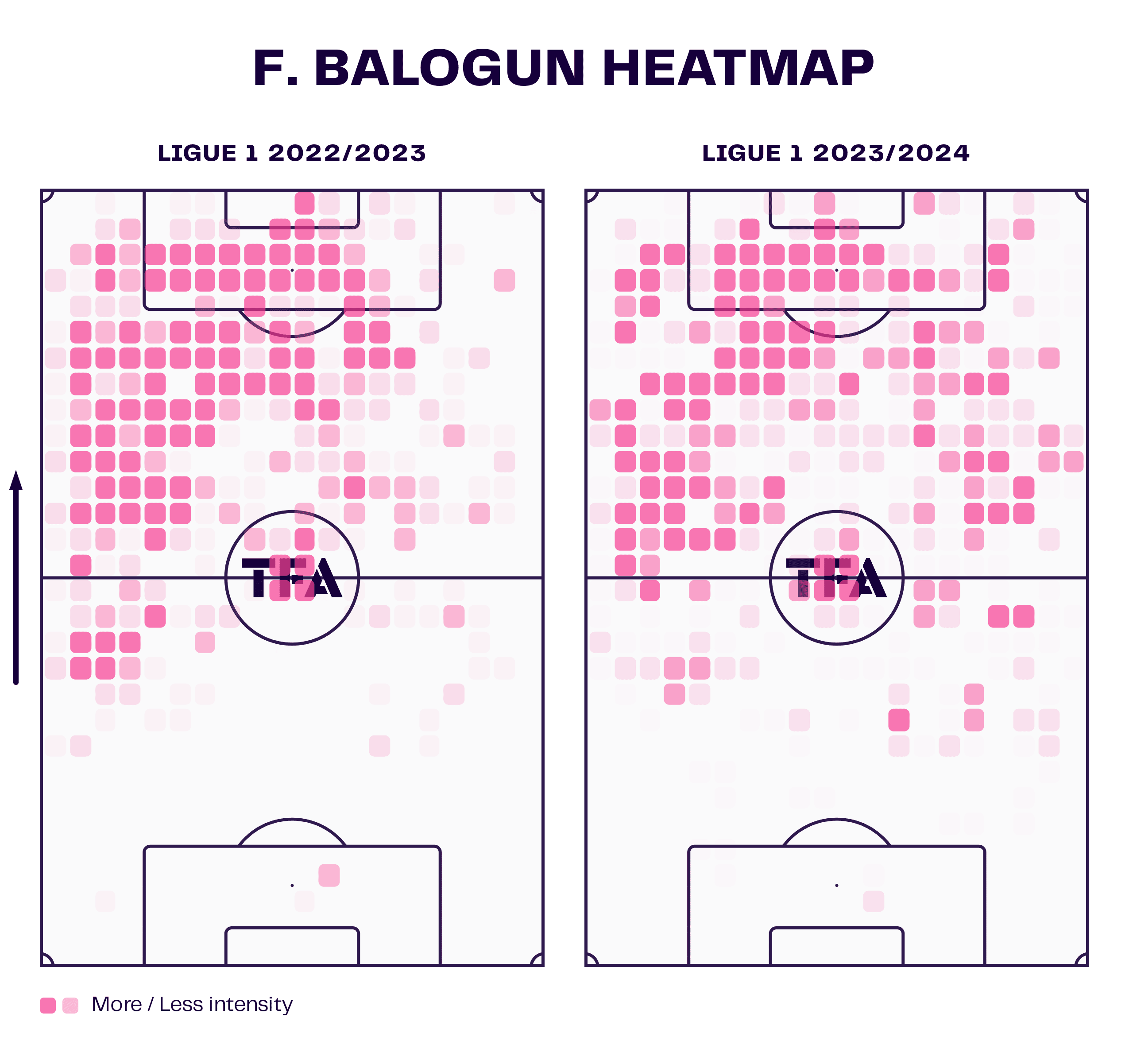
The heatmap shows that Balogun would tend to occupy spaces on the left channel as well as more centrally.
By occupying areas on the left, it facilitated dribbles and progressive runs into more advanced areas of the pitch, such as just inside the penalty area on slightly wider angles.
As the previous shot graphic showed, the former Gunner would often attempt a shot at goal from such wider areas.
Playing on the left side of attack was not unusual practice for the forward as he previously operated on the left during his youth career at Arsenal.
However, it is noticeable from the heatmaps that this season, he has featured more on the right, an unnatural position for the forward.
Moreover, as Monaco’s opposition tends to utilise a lower block more often than Reims’ opponents, driving the ball into space can be more of a challenge.
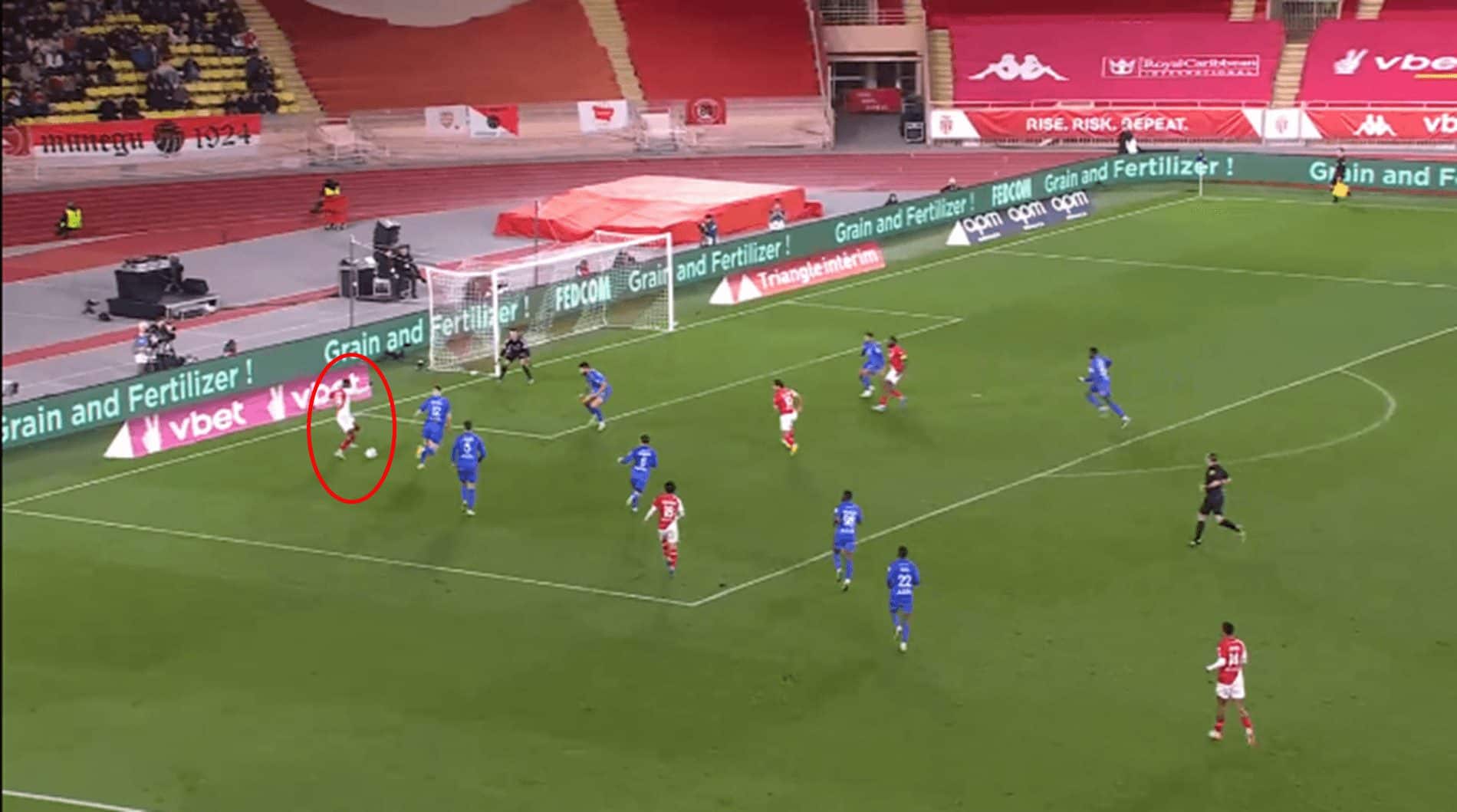
Balogun has worked an opening into the box, but the angle is too tight to try an effort at goal himself.
No Monaco players make a move toward the six-yard box either, and so Balogun hesitates before attempting a cross which is subsequently blocked.
The block is unsurprising, given the congested penalty area.
Monaco are a much more possession-orientated side as only PSG and Lille have averaged more possession in France’s top flight.
Monaco are strong with direct attack movements, but their attacking play is more varied than Still’s side as their possession game ensures they are more comfortable in build-up attacks.
Monaco has so far played 209 sequences in Ligue 1 with more than 10 passing movements.
This is in contrast to Reims, who have only played 143 such sequences.
This highlights the more patient build-up adopted at Monaco with passing transitions.
However, looking to transition through the thirds of the pitch does not conform with Balogun’s strengths, as there is room for improvement with his possessional play.
The youngster ranks below the median for percentage of accurate passes compared to other centre-forwards this season in tier one.
Moreover, he ranks in the lower 50% for progressive passes per 90 and dangerous passes per 90 amongst the same peers.
This suggests he has been less successful in linking up with his attacking counterparts.
Even within the Monaco squad, Balogun ranks at the lower end for short and middle-type pass accuracy; he ranks lowest in the squad for long-range passing accuracy among players to have featured for at least one 90, having only successfully completed 25% of his attempted long balls.
Whilst forwards are not typically known for their long-range passing, it can be useful in the wide areas if the opportunity arises to switch the play.
However, this is another passing area where Balogun has been weak this campaign, as he is yet to complete a switch of play.
It points to a lack of variety in Balogun’s passing, which does not bode well when trying to bed into a side looking to play possession-based football.
It is no coincidence that Balogun’s goal-scoring success at Monaco is reminiscent of his time at Reims.
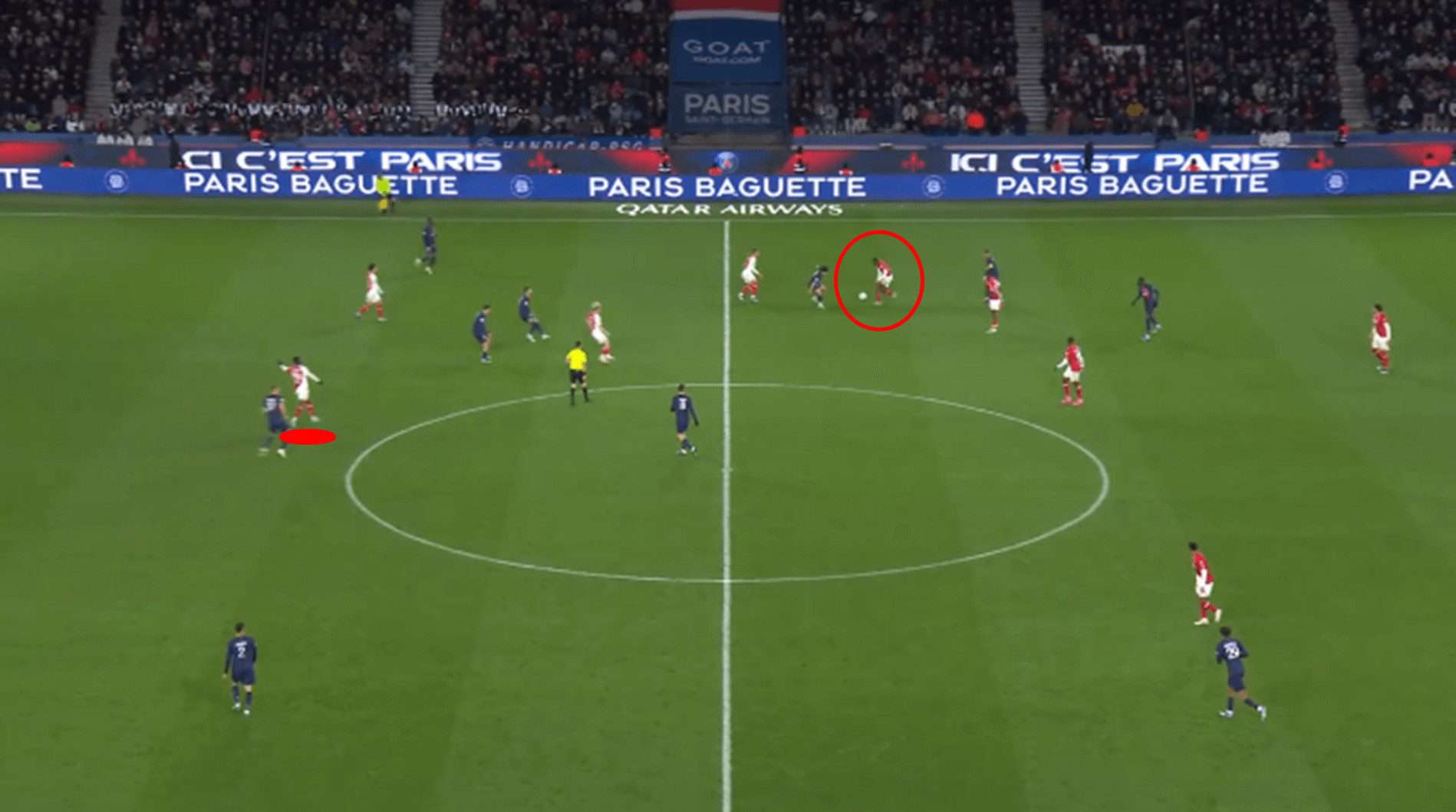
Monaco has just regained possession here, and Balogun is positioned centrally off the shoulder of the last defender.
Balogun is seen instructing his teammate to make the pass.
Although the ball is played forward, it’s not to Balogun.
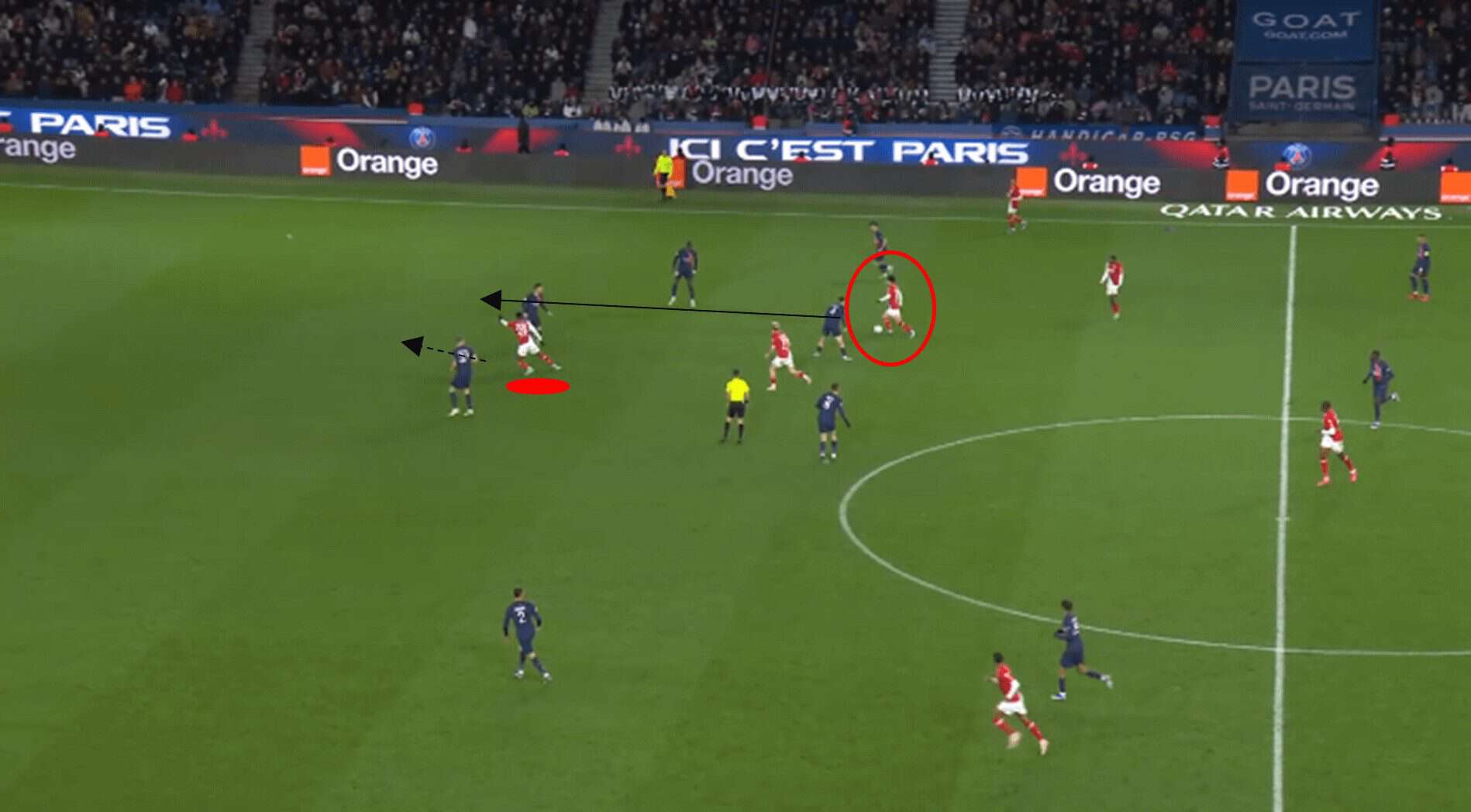
Balogun does, however, eventually receive the pass he wanted.
Just like at Reims, Balogun uses his pace to drive forward to score in a one-on-one situation.
Although the 22-year-old was able to execute his preferred attacking style of play in this instance, his off-the-ball movement was almost not rewarded as Mohamed Camara was not in sync with Balogun’s positioning.
This points to a lack of understanding between the former Arsenal youngster and his new teammates.
Not on the same wavelength
As the Reims’ tactics were tailored to suit Balogun, there was an understanding within the side about how possession would be used.
One player who had a strong understanding of Balogun was Alexis Flips.
Of the 15 non-penalty league goals that Balogun scored for Reims, Flips assisted 27% of these goals.
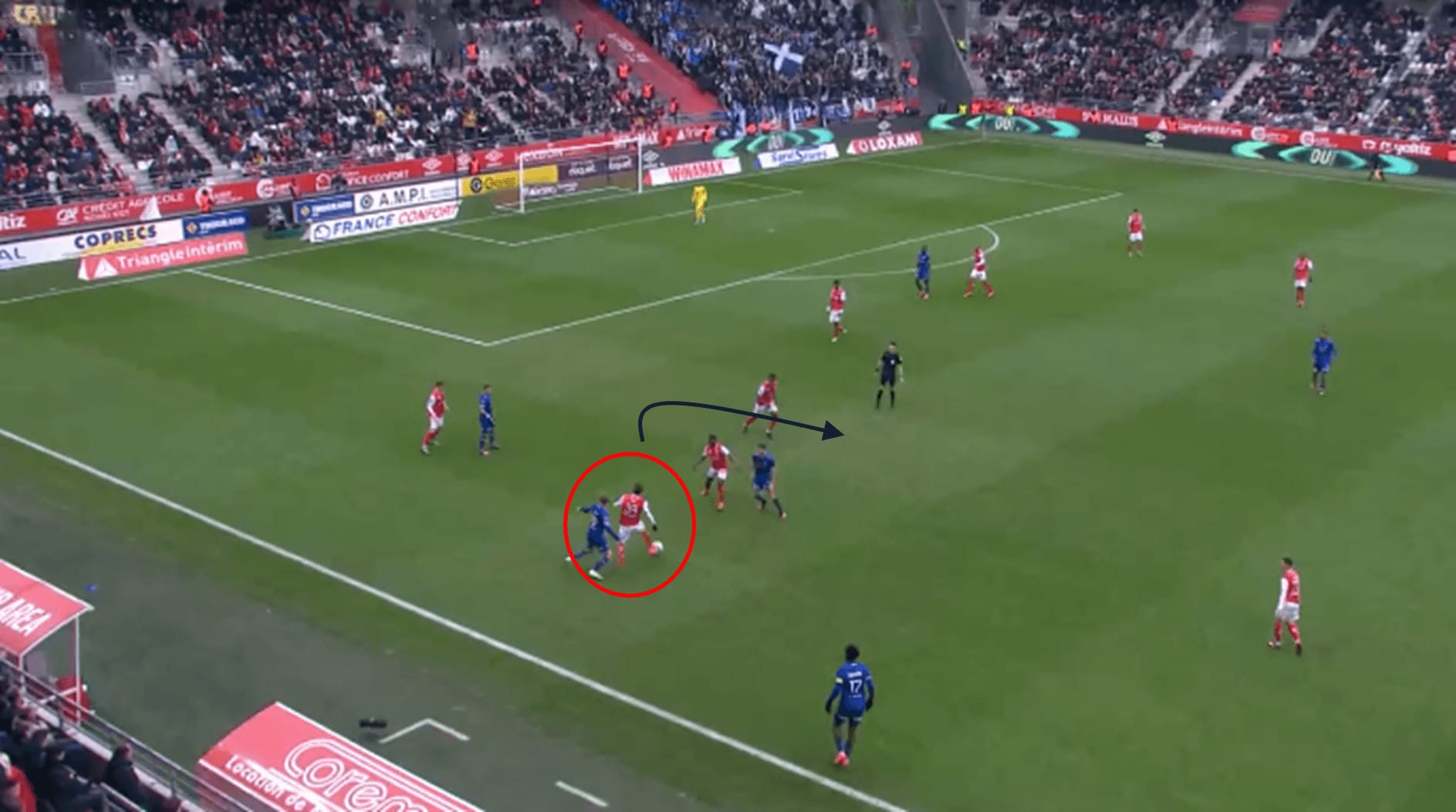
From the opposition throw-in, Reims takes advantage of a poor first touch, and Junya Ito dribbles away from danger before redirecting himself to initiate an attack.
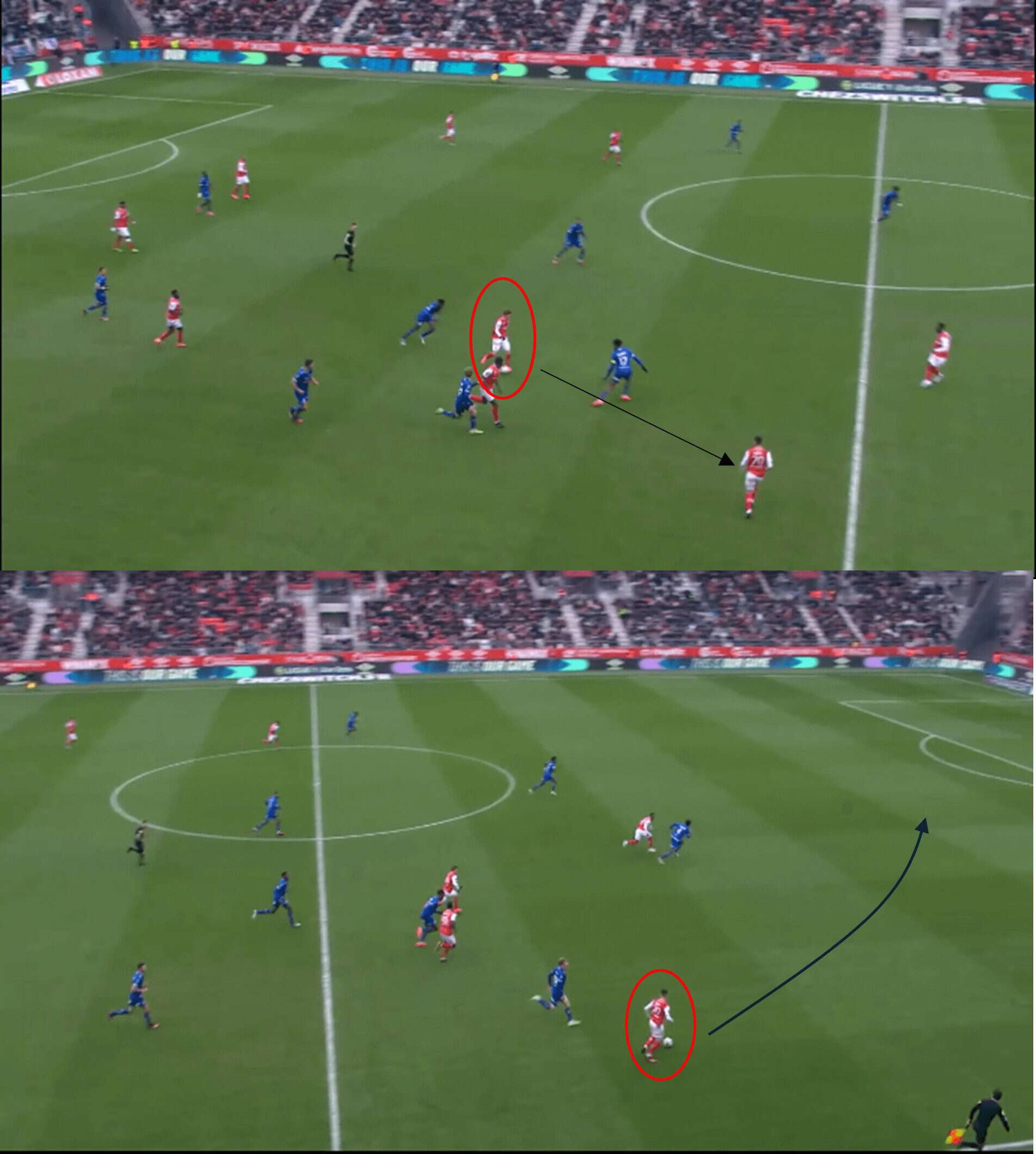
Ito plays a pass into Flips, who, following some quick feet, angles a well-weighted ball towards Balogun to run onto with only the keeper to beat.
Balogun does just that.
This is a further example of the direct play adopted by Reims last campaign but also, the quick thinking by Flips and Balogun.
A quick look up, and Flips knew where to play the perfect ball for his teammate to score.
The same slick, quick passing movements have not always been on display at Monaco this season, where Balogun is concerned.
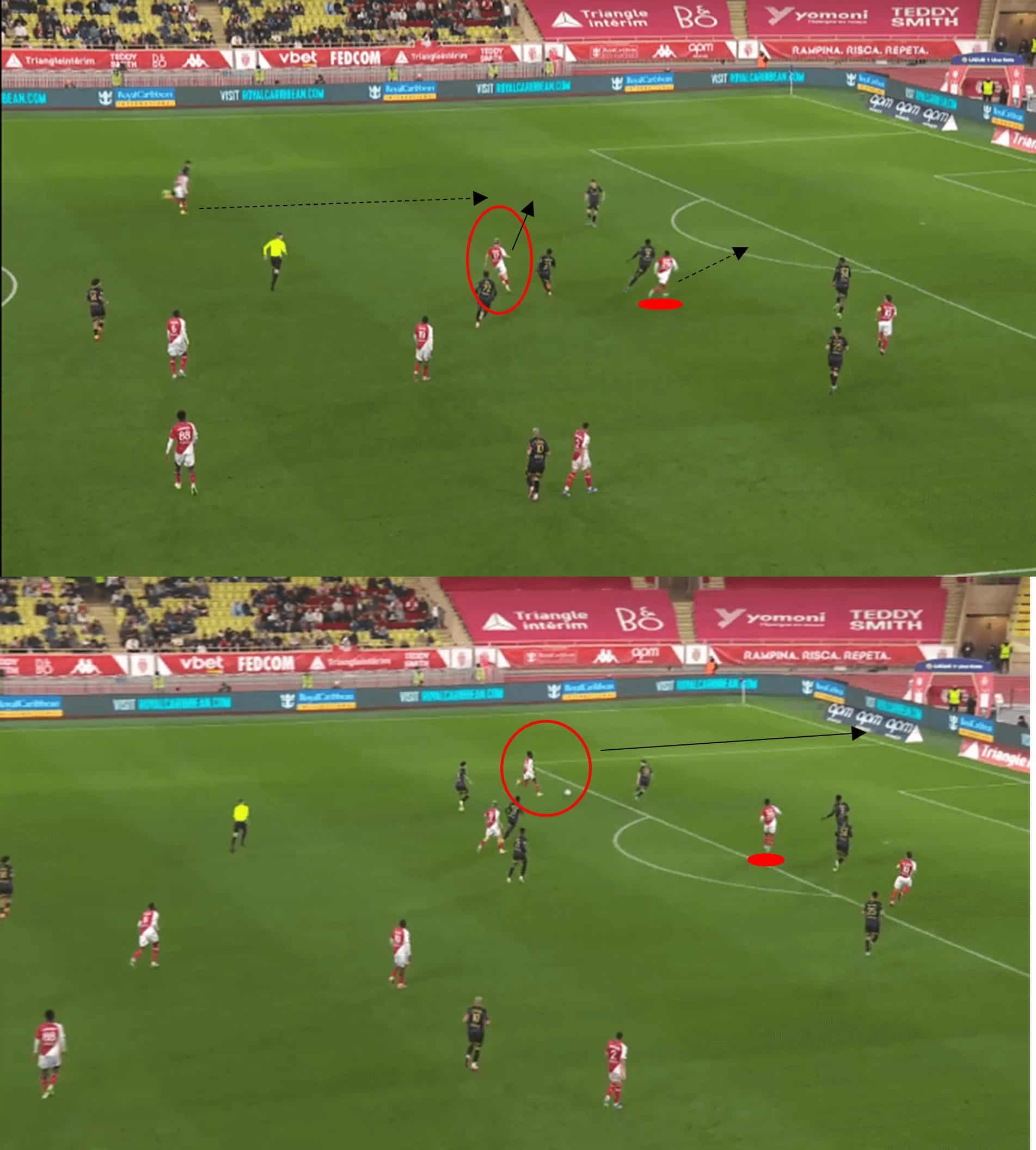
Following a high press, Balogun regains possession for his side and quickly plays a pass, anticipating a quick one-two combination.
However, following slow decision-making, the pass is played out wide.
However, Monaco failed to take advantage of this as a poor first touch ensures the ball goes out for a goal kick.
Even though poor control brought an end to the attack, the pass out wide was not the right move.
Even if Monaco had controlled the ball out wide, by the time a cross would have come in, the penalty area would have been congested.
Had Balogun’s teammate been on the same wavelength, the 22-year-old would have had a quick pass played centrally into the penalty area.
From this area, there would have been a more favourable angle for a shot and, hence, a greater opportunity to score.
Discussions may need to be had in the Monaco ranks to get on the same page with the attacking intentions of the former Arsenal graduate.
Conclusion
In this tactical analysis and scout report, we have shown that Balogun is scoring fewer goals per match this season compared to last whilst on loan at Reims.
However, despite a decline in goals, Balogun has been just as efficient, given the opportunity.
This analysis has further shown that due to a change in positioning, the 22-year-old forward has been less effective upfront.
However, the former Arsenal man’s goal decline is also a product of a different playing style.
We have shown that due to Balogun’s pace and underwhelming possession credentials, he thrives on a more direct style of attacking play.
Moreover, we have uncovered that the USA international’s teammates are not on this wavelength in terms of his passing and movement in the final third.
There is of course time to rectify this and Adi Hütter may need to adopt a change of tact if Balogun is to ascertain that he is no one-season wonder.






Comments